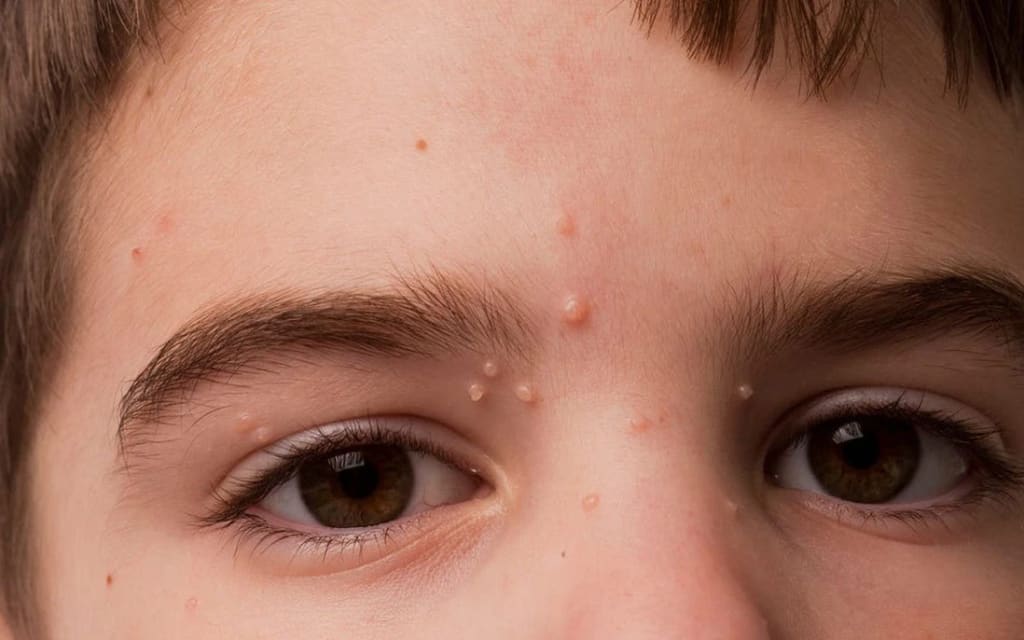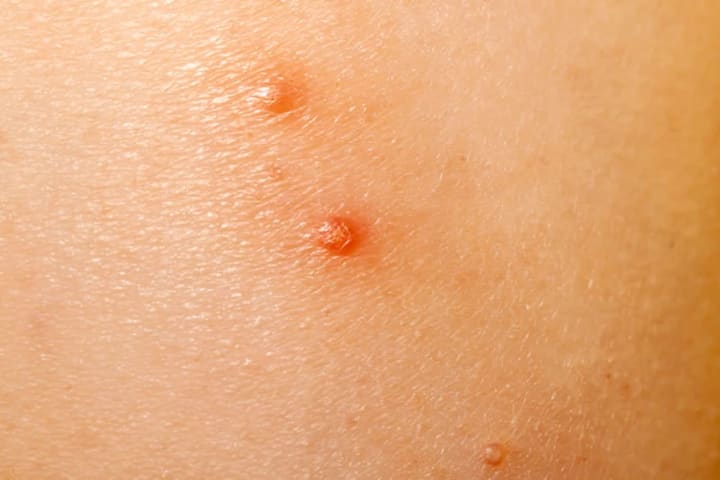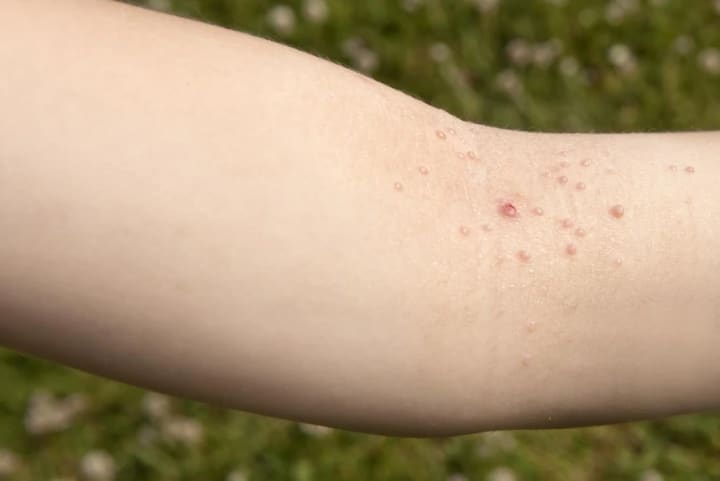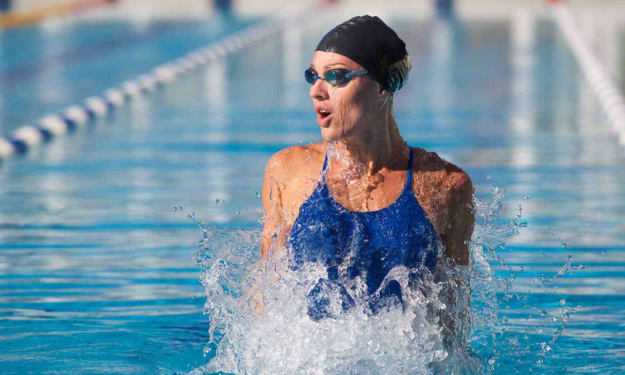Molluscum contagiosum: Causes, symptoms, stages and treatment
Molluscum contagiosum is an infection that causes small bumps on the skin and can be spread through contact with viruses. Although the disease usually heals on its own, there are several treatment options.

What disease is molluscum contagiosum? Is molluscum contagiosum dangerous? Below is information about this condition as well as how to treat it.
1. What is molluscum contagiosum?
Molluscum contagiosum is a skin infection caused by a virus. The infection creates small, raised bumps on the skin, shaped like a pearl. These bumps are usually white but can be the same color as natural skin or range in color from pink to purple.
Acne caused by infection can form anywhere on the skin but is most common on the face, neck, arms, legs or genitals.
Small pimples are usually painless. They heal on their own without treatment and rarely leave scars. The duration of the virus's existence is different for each person, but these acne can last from 2 months to 4 years.
Molluscum contagiosum is a common condition. The exact incidence rate is unknown because this condition will go away on its own, so many people do not seek medical attention.

2. Is molluscum contagiosum contagious?
As the name suggests, molluscum contagiosum can be transmitted between people through direct skin contact with someone infected with the virus or by touching an object contaminated with the virus, such as towels or clothing.
Molluscum contagiosum is more common in children than in adults. Because the virus spreads more easily in children due to:
- Children come into contact with each other while going to school and playing sports.
- Children often share toys and supplies at school and daycare.
- Molluscum contagiosum is often spread in community swimming pools, possibly through towels and toys.
- Children easily spread the virus to other parts of their body. This happens when a child scratches the rash and then touches another part of the body.
3. Symptoms of molluscum contagiosum
When exposed to the molluscum contagiosum virus M. contagiosum, you may not see symptoms of infection for up to 6 months. These symptoms usually take 2 to 7 weeks to appear from the time you are infected with the molluscum contagiosum virus.
Symptoms of molluscum contagiosum range from mild to severe and include:
- Acne looks like pimples or warts on the skin, 2 to 5 mm in diameter.
- Papules are white, the same color as your natural skin color or pink to purple.
- Papules have a small indentation in the center.
- Papules are hard but can become soft over time.
- Papules may ooze clear or white fluid.
- Itchy skin.
- Acne appears anywhere except the palms of the hands or soles of the feet. It especially often appears on the face, abdomen, trunk, arms and legs of children or the inner thighs, genitals and abdomen of adults.
If you scratch the pimple and it spreads. This causes:
- Multiple pimples form in a row or cluster near the area of the original papule.
- The skin around the papules swells, enlarges and turns red to purple.
- The papules become painful.

4. Stages of molluscum contagiosum
The molluscum rash changes shape throughout the course of the infection. The total time for the virus to develop is usually about 6 to 12 months. In rare cases, it can last up to several years.
Viruses have many different stages and often many at the same time. Below are the stages of molluscum contagiosum:
- Molluscum contagiosum in the early stages
At first, the rash looks like pinheads: small, shiny, skin-colored bumps or domes. This usually happens between 2 weeks and 2 months after you are exposed to the virus.
- Molluscum contagiosum forms
As the rash progresses, the pimples get larger and you can often see an indentation in the middle. Sometimes, the rash also becomes itchy.
- Molluscum contagiosum
As molluscum contagiosum progresses over weeks and months, the central depression often has a white core. The surrounding area may also become red and irritated. Although the rash may appear more severe, this stage actually means your body is starting to fight the virus.
- Healing phase (final)
After a few months, the rash will gradually disappear. In the final stages, you will sometimes notice some residual red or brown areas of irritated skin.

5. What is the treatment for molluscum contagiosum?
There are many different methods to treat and cure molluscum contagiosum. The best treatment for you depends on several factors, such as how uncomfortable or widespread it is.
- Topical
Topical medication is applied directly to soft spots on the skin. Some of these treatments you can apply at home. Most of these treatments take several weeks to work.
Here are some common prescription topical treatments for molluscum contagiosum:
+ Cantharidin (Ycanth): Cantharidin is the only FDA-approved treatment for molluscum contagiosum. It forms a small blister, which helps remove the mollusk.
+ Retinoids: Typically, you will apply a retinoid cream (like tretinoin) 3 times a week at home. Retinoids cause local skin irritation, stimulating the immune system to eliminate viruses.
+ Imiquimod (Aldara): Imiquimod is another prescription cream that you can apply 2 to 3 times a week at home. It also stimulates the immune system to fight viruses.
+ Podofilox (Condylox): Podofilox is a prescription cream that you can apply at home twice a day for 3 days, then do not require treatment for 4 days. It also causes skin irritation and stimulates the immune system.
For over-the-counter (OTC) treatments, salicylic acid and benzoyl peroxide may be good options. You will apply these 3 to 4 nights a week. These treatments also cause irritation and stimulate the immune system.
- Drug
Research shows that oral cimetidine (Tagamet) is effective in some children, especially those with other skin conditions such as eczema. Having a skin condition can make it easier for the immune system to fight viruses. But people often need to use cimetidine in combination with other topical treatments.
- Curettage
This is a procedure in which a dermatologist anesthetizes and then scrapes away the bumps. But this treatment is not a cure. Because the virus is still active in the body, the rash may return elsewhere.
- Cryotherapy
Molluscum contagiosum can also be frozen with liquid nitrogen. The main disadvantage of this treatment is that it can be painful. It can also lead to scarring. And, like curettage, it is not a cure.
- Laser
This treatment uses special laser equipment to remove papules. However, this method is quite expensive.
6. What happens if molluscum contagiosum becomes infected?
The most common complication of molluscum contagiosum is secondary infection in one of the pimples. This is more likely to happen if you scratch them a lot. This can introduce bacteria into the skin, which then turns into a secondary infection in the pimples.
A bacterial skin infection is called cellulitis. Signs of cellulitis include:
- Increased redness and warmth in the surrounding area
- Pain when touched
- Fever or chills
- Other flu-like symptoms, such as joint pain or discomfort.
It's important to note that signs of inflammation - like fluid-filled pimples and redness - are one of the natural stages of molluscum contagiosum. As mentioned above, this usually occurs weeks to months after the rash appears. And that's actually a sign that your body's immune system is fighting the rash.
But these changes will not cause pain or fever. Therefore, when you suspect an infection, you should go to the hospital for examination. If it is cellulitis, you may need antibiotics to treat it.
7. Can molluscum contagiosum be prevented?
The best way to prevent molluscum contagiosum infection is to avoid touching other people's skin when they have the infection. In addition, some tips can also help you prevent the spread of infection such as:
- Wash your hands regularly with warm water and soap. In particular, children should be instructed in hand washing techniques because they are more likely to touch them when playing and interacting with others.
- Avoid sharing personal items. This includes towels, clothes, hairbrushes or soap.
- Avoid sharing sports equipment that may come into direct contact with other people's bare skin.
- Avoid touching skin areas with acne spots
- Keep papules clean and covered to prevent yourself or others from touching them and spreading the virus.
- Avoid shaving or using electrolysis on areas with acne.
- Avoid having sex if you have papules in the genital area.
About the Creator
Ken aquariums
Telling stories my heart needs to tell <3 life is a journey, not a competition
If you like what you read, feel free to leave a tip,I would love some feedback
https://www.pinterest.com/Ken_Aquariums
https://s.shopee.vn/1B0pL9ZA9m
Enjoyed the story? Support the Creator.
Subscribe for free to receive all their stories in your feed. You could also pledge your support or give them a one-off tip, letting them know you appreciate their work.






Comments
There are no comments for this story
Be the first to respond and start the conversation.